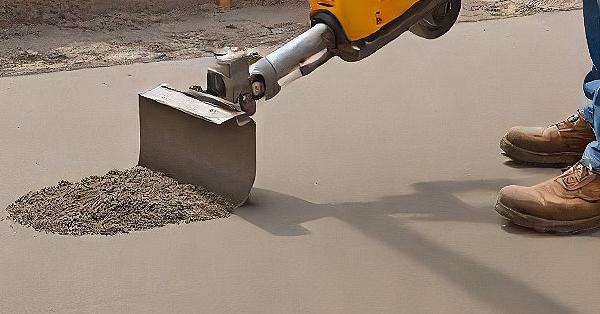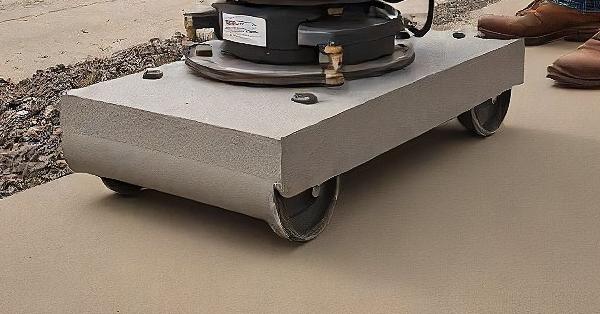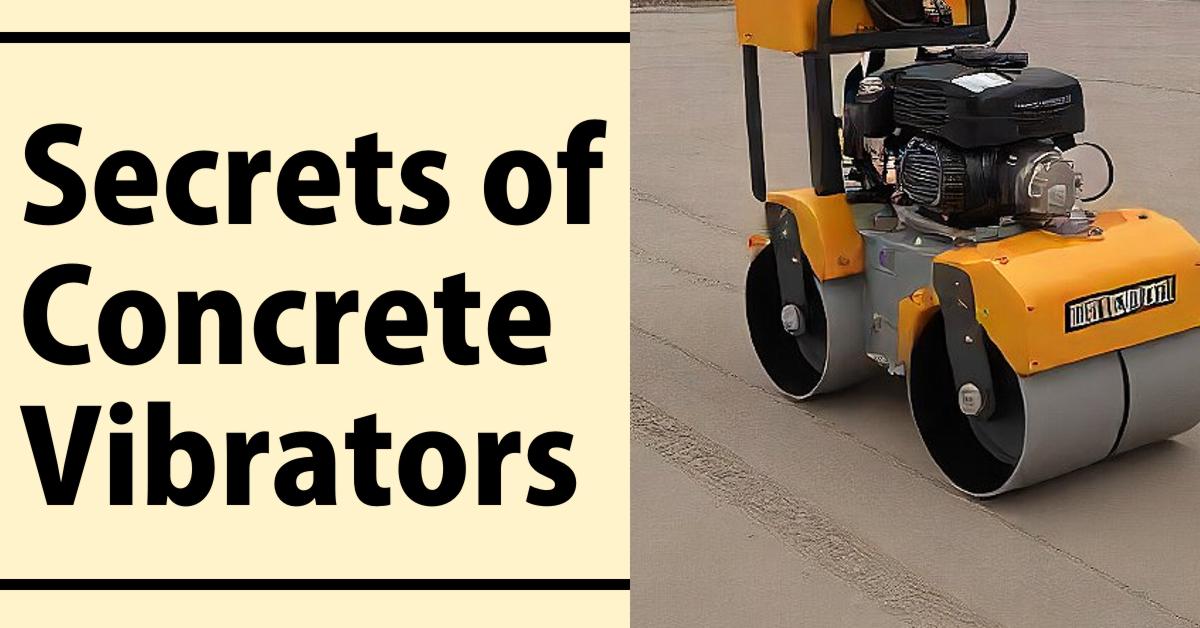I firmly believe that the key to successful concrete construction lies in meticulous attention to detail and the ability to adapt to the unique demands of each project. Over the years, I have honed my expertise in selecting the appropriate vibrator types, fine-tuning their settings, and implementing tailored techniques to tackle even the most challenging concrete applications.
Concrete vibrators are essential in the construction industry, ensuring proper consolidation and compaction of concrete mixtures. As a licensed civil engineer and construction specialist with over 25 years of experience, I, Steve Axton, have witnessed the vital role these vibrators play in achieving high-quality concrete structures. Here I will share different types of concrete vibrators, their applications, safety standards, and best practices for their effective use based on my 25 years of experience.

Vibrator Selection Matrix
| Vibrator Type | Ideal Application | Key Considerations |
|---|---|---|
| Poker Vibrators | General construction, deep pours | Frequency range, amplitude, power source |
| Flexible Shaft Vibrators | Confined spaces, complex rebar | Shaft length, vibration intensity, durability |
| Formwork Vibrators | Large-scale projects, high-efficiency | Clamping mechanisms, force adjustment |
| Surface Vibrators | Slabs, pavements, bridge decks | Surface type, size variations, operational techniques |

Consolidation Depth and Vibration Time Correlation
| Pour Depth (inches) | Recommended Vibration Time (seconds) |
|---|---|
| 6-12 | 5-15 |
| 12-24 | 10-25 |
| 24-36 | 20-40 |
| 36+ | 30+ (multiple insertions) |
Internal Vibrators
Poker Vibrators
Poker vibrators, also known as immersion vibrators, are the most common type of internal vibrators. They are characterized by their sleek, poker-like design, allowing them to penetrate deep into the concrete mixture. I have employed poker vibrators extensively for foundation work, including footings and slabs. The ability to adjust the frequency range and amplitude settings has proven invaluable in achieving the desired level of consolidation without compromising the integrity of thin concrete sections or causing surface defects.
Case Study:
During a recent project involving a basement foundation, I opted for a poker vibrator with a lower frequency range of around 8,000 VPM to prevent excessive vibration and potential cracking. By carefully monitoring the vibration intensity and adjusting the insertion pattern, I ensured uniform compaction throughout the pour, resulting in a dense and structurally sound foundation.
Poker Vibrator Selection Matrix
| Factor | Range/Options | Considerations |
|---|---|---|
| Frequency Range | 8,000 – 12,000 VPM | Higher frequencies for better consolidation, lower frequencies for thin sections or to avoid surface defects |
| Amplitude Settings | Adjustable or Fixed | Adjustable settings allow for better control over vibration intensity based on mix design and project requirements |
| Power Source Types | Electricity, Gasoline, Compressed Air | Job site conditions and accessibility may dictate the most suitable power source |
| Shaft Length | 6 – 20 feet | Longer shafts for deeper pours, shorter shafts for shallow or confined areas |
| Vibration Intensity | Adjustable or Fixed | Adjustable intensity helps prevent over-vibration or under-consolidation |
Frequency Range
Poker vibrators typically operate at frequencies ranging from 8,000 to 12,000 vibrations per minute (VPM), ensuring efficient consolidation.
Amplitude Settings
Some models offer adjustable amplitude settings, allowing you to control the vibration intensity based on the concrete mix design and project requirements.
Power Source Types
Poker vibrators can be powered by electricity, gasoline, or compressed air, providing flexibility for different job site conditions.
Flexible Shaft Vibrators
Flexible shaft vibrators are ideal for narrow spaces or areas with intricate rebar configurations. They feature a flexible shaft that can bend and maneuver through tight spots.
Shaft Length Options
These vibrators are available in various shaft lengths, typically 6 to 20 feet, accommodating different concrete pour depths.
Vibration Intensity
The vibration intensity of flexible shaft vibrators is often adjustable, ensuring optimal consolidation without causing over-vibration or segregation.
Durability Concerns
While flexible, the shafts of these vibrators are prone to wear and tear, requiring regular inspection and maintenance.
External Vibrators
Formwork Vibrators
Formwork vibrators are mounted on the exterior of concrete formwork and transmit vibrations through the formwork and into the concrete mixture.
Clamping Mechanisms
These vibrators feature robust clamping mechanisms that securely attach to the formwork, ensuring efficient vibration transfer.
Force Adjustment
Many formwork vibrators offer force adjustment capabilities, allowing you to fine-tune the vibration intensity based on the concrete mix and formwork thickness.
Operational Efficiency
Formwork vibrators are highly efficient, especially for large-scale projects, as they can cover extensive areas without the need for manual manipulation.
Surface Vibrators
Surface vibrators, also known as screed board vibrators, are designed to consolidate concrete slabs or horizontal surfaces.
Types of Surfaces
These vibrators can be used on various surfaces, including floors, pavements, and bridge decks, providing versatility in their applications.
Size Variations
Surface vibrators come in different sizes, ranging from lightweight handheld models to larger, ride-on units for extensive projects.
Operational Techniques
Proper operational techniques, such as overlapping vibration paths and maintaining consistent speed, are crucial for achieving uniform consolidation.
H2: Applications and Techniques
H3: Infrastructure Projects
Bridge Construction
In bridge construction, internal vibrators are essential for consolidating concrete in deep pours and ensuring proper compaction around intricate rebar configurations.
Consolidation Depth
The consolidation depth achieved by internal vibrators depends on factors such as the concrete mix design, vibrator frequency, and insertion pattern.
Vibration Time
Sufficient vibration time is crucial to achieve proper consolidation without risking over-vibration, which can lead to segregation or surface defects.
Rebar Interference
Flexible shaft vibrators are particularly useful in areas with dense rebar configurations, allowing for effective consolidation while avoiding interference.
Roadways
For roadway construction, surface vibrators are commonly employed to consolidate concrete slabs and ensure uniform compaction across the entire surface.
Layered Application
In some cases, a layered approach may be used, where internal vibrators consolidate the initial layer, followed by surface vibrators for the subsequent layers.
Edge Compaction Techniques
Special techniques, such as using hand-held immersion vibrators or high-cycle surface vibrators, are employed to ensure proper compaction along edges and corners.
Seasonal Adjustments
Adjustments to vibration parameters may be necessary based on seasonal temperature variations, which can affect the workability and setting time of the concrete mix.
H3: Residential Construction
Foundation Work
Internal vibrators are essential for proper consolidation of concrete footings and foundation slabs in residential construction.
Footings Application
Poker vibrators are commonly used to consolidate concrete footings, ensuring uniform compaction and eliminating potential voids or air pockets.
Vibration Frequency to Avoid Cracks
Careful consideration of vibration frequency is necessary to prevent excessive vibration, which can lead to surface cracks or delamination in thin concrete sections.
Rebar Configuration
The rebar configuration in residential foundations often requires the use of flexible shaft vibrators to ensure proper consolidation around the reinforcement.
Wall Construction
For concrete wall construction, internal vibrators are employed to consolidate the concrete within the formwork.
Wall Thickness
The thickness of the wall dictates the vibrator type and insertion pattern, with thicker walls requiring longer vibrators or multiple insertion points.
Vibration Penetration
Proper vibration penetration is crucial to eliminate air pockets and ensure uniform consolidation throughout the wall section.
Air Pocket Elimination
Careful vibration techniques, such as inserting the vibrator at an angle and slowly withdrawing it, can help eliminate air pockets and ensure a dense, homogeneous concrete structure.
H2: Safety Standards
H3: Personal Protective Equipment (PPE)
Vibration Gloves
Vibration gloves are essential PPE for operators handling concrete vibrators, as they help reduce the transmission of vibrations to the hands and arms.
Materials and Fabrics
These gloves are typically made from specialized materials and fabrics designed to absorb vibrations and provide a secure grip.
Damping Characteristics
The damping characteristics of vibration gloves are crucial in minimizing the effects of prolonged exposure to vibrations, which can lead to hand-arm vibration syndrome (HAVS).
Fit and Comfort
Proper fit and comfort are important considerations when selecting vibration gloves, as ill-fitting gloves can reduce their effectiveness and cause discomfort during extended use.
Safety Goggles
Safety goggles or face shields are recommended when operating concrete vibrators to protect the eyes from potential debris or splashes.
Impact Resistance
The goggles should be impact-resistant and designed to withstand potential impacts from concrete fragments or other job site hazards.
Anti-Fog Technology
Anti-fog technology in safety goggles helps maintain clear visibility, which is essential for safe operation and monitoring of the vibration process.
UV Protection
For outdoor applications, safety goggles with UV protection can help prevent eye strain and potential long-term damage from prolonged exposure to sunlight.
H3: Operational Protocols
Pre-Operation Checklist
Implementing a pre-operation checklist is crucial for identifying potential issues and ensuring safe operation of concrete vibrators.
Emergency Procedures
Clear emergency procedures should be established and communicated to all personnel, covering scenarios such as equipment malfunctions, power outages, or accidents.
Maintenance Practices
Regular maintenance practices, including cleaning, inspection, and repair, are essential for ensuring the safe and efficient operation of concrete vibrators.
H2: Maintenance and Care
H3: Cleaning and Storage
Proper Cleaning Agents
Using the appropriate cleaning agents is crucial for removing concrete residue and preventing premature wear or damage to the vibrator components.
Biodegradable Solutions
Whenever possible, biodegradable cleaning solutions should be used to minimize environmental impact and ensure compliance with relevant regulations.
Brush Types
Various brush types, such as wire brushes or nylon bristle brushes, can be employed for effective cleaning of concrete vibrators, ensuring thorough removal of dried concrete residue.
Dry Storage Tips
After cleaning, proper dry storage is essential to prevent moisture accumulation and potential corrosion or damage to the vibrator components.
Storage Environment
The storage environment should be clean, dry, and free from potential contaminants or hazards that could impact the vibrator’s performance or longevity.
Humidity Control
In humid environments, additional measures such as dehumidifiers or moisture-absorbing materials may be necessary to maintain an optimal storage environment for concrete vibrators.
Temperature Effects
Extreme temperatures, both hot and cold, can have detrimental effects on concrete vibrators. Storing them in a temperature-controlled environment is recommended to ensure their longevity and reliable performance.
Physical Protection
Proper physical protection, such as storage racks or designated areas, should be implemented to prevent accidental damage or impact during storage.
H3: Routine Inspections
Concrete Vibrator Maintenance Checklist
| Inspection Point | Frequency |
|---|---|
| Wear and Tear Assessment | Monthly |
| Cable Integrity Check | Weekly |
| Head Wear Patterns | Monthly |
| Connection Points | Monthly |
| Vibration Intensity Tests | Quarterly |
| Power Efficiency Checks | Quarterly |
| Noise Level Monitoring | Weekly |
Wear and Tear Assessment
Regular inspections are crucial for assessing wear and tear on concrete vibrators, particularly on components subject to frequent vibration or exposure to abrasive materials.
Cable Integrity
For vibrators with electrical cables, inspecting the cable integrity is essential to identify any potential damage, fraying, or exposed wires that could pose safety risks or impact performance.
Head Wear Patterns
Inspecting the vibrator head for wear patterns can provide valuable insights into the effectiveness of the vibration and potential areas of concern or replacement needs.
Connection Points
Connection points between the vibrator head and shaft, or between the shaft and power source, should be inspected for any looseness, corrosion, or potential failure points.
Functional Testing
Periodic functional testing, including vibration intensity tests and power efficiency checks, can help identify any potential performance issues or the need for maintenance or repairs.
Vibration Intensity Tests
Vibration intensity tests can be conducted to ensure that the vibrator is operating within the specified frequency and amplitude ranges, ensuring optimal consolidation performance.
Power Efficiency Checks
For electrically or gasoline-powered vibrators, power efficiency checks can help identify any potential issues with the power source or energy consumption, allowing for timely maintenance or repairs.
Noise Levels
Monitoring noise levels during operation can provide insights into the vibrator’s condition and potential maintenance needs, as excessive noise can indicate wear or potential component failures.
Conclusion
Concrete vibrators play a vital role in ensuring the quality and durability of concrete structures. By understanding the different types of vibrators, their applications, and proper maintenance practices, construction professionals can achieve optimal consolidation and compaction of concrete mixtures. As a licensed civil engineer and construction specialist with over 25 years of experience, I cannot emphasize enough the importance of selecting the right vibrator for the job, following safety protocols, and implementing proper maintenance routines. By doing so, you can ensure the longevity and reliable performance of these essential tools, contributing to the successful completion of your construction projects.
Last Words and Key Takeaway Remember, concrete vibrators are powerful tools that require careful handling and adherence to safety standards. Invest in high-quality vibrators from reputable manufacturers, train your personnel on proper usage techniques, and prioritize regular maintenance. By doing so, you can maximize the efficiency of your concrete consolidation efforts and create durable, long-lasting structures that stand the test of time.
Steve Axton: A Veteran in Concrete Vibration With over 25 years of experience in the construction industry, I, Steve Axton, have witnessed the evolution of concrete vibration techniques and the crucial role these tools play in achieving high-quality concrete structures. Throughout my career, I have gained invaluable insights into the selection, operation, and maintenance of concrete vibrators, ensuring optimal consolidation and compaction results. My expertise spans various construction projects, from residential foundations to large-scale infrastructure developments, and I firmly believe in sharing my knowledge to empower fellow professionals in the field.
Verified Advice
What is the primary purpose of concrete vibrators?
The primary purpose of concrete vibrators is to consolidate and compact concrete mixtures, eliminating air pockets and voids, and ensuring a dense, homogeneous structure.
How do internal and external vibrators differ?
Internal vibrators, such as poker and flexible shaft vibrators, are inserted directly into the concrete mixture, while external vibrators, like formwork and surface vibrators, transmit vibrations from the outside through the formwork or surface.
What factors should be considered when selecting a concrete vibrator?
Factors to consider include the concrete mix design, pour depth, rebar configuration, project size, and accessibility to ensure efficient consolidation and compaction.
How does the vibration frequency affect concrete consolidation?
Higher vibration frequencies generally result in better consolidation and compaction, but excessive vibration can lead to segregation or surface defects. Finding the optimal frequency range for the specific concrete mix is crucial.
Can concrete vibrators be used for residential construction projects?
Yes, concrete vibrators are essential for residential construction projects involving foundations, footings, walls, and slabs. Proper vibrator selection and techniques are vital to ensure quality and prevent cracking or delamination.
What safety precautions should be taken when operating concrete vibrators?
Safety precautions include wearing appropriate personal protective equipment (PPE) such as vibration gloves and safety goggles, following operational protocols, and implementing proper maintenance practices.
How often should concrete vibrators be inspected and maintained?
Regular inspections and maintenance should be performed according to the manufacturer’s recommendations or based on the vibrator’s usage and exposure to harsh environments. Routine inspections can help identify potential issues and prevent failures.
Can the wrong vibrator type or improper usage lead to concrete defects?
Yes, using the wrong vibrator type or improper usage techniques can lead to various concrete defects, such as honeycombing, segregation, or surface cracking. It’s crucial to select the appropriate vibrator and follow best practices for consolidation.
How does the concrete mix design affect vibrator selection and usage?
The concrete mix design, including factors like slump, aggregate size, and admixtures, can influence the vibrator selection and the required vibration parameters. Adjustments may be necessary to achieve optimal consolidation.
Are there any environmental considerations when using concrete vibrators?
Yes, measures should be taken to minimize environmental impact, such as using biodegradable cleaning solutions and implementing proper storage practices to prevent contamination.
Can concrete vibrators be used in confined spaces or areas with limited access?
Yes, flexible shaft vibrators and specialized vibrators designed for confined spaces can be used in areas with limited access or tight spaces, ensuring proper consolidation in challenging environments.
How does the consolidation depth affect the vibration time required?
Generally, deeper concrete pours require longer vibration times to ensure proper consolidation throughout the entire depth. The vibrator insertion pattern and depth should be adjusted accordingly.
Can concrete vibrators be used for other applications besides construction?
While primarily used in construction, concrete vibrators can also be employed in various other applications that require the compaction or consolidation of granular materials, such as soil stabilization or ground improvement techniques.
What training or certification is required for operating concrete vibrators?
While specific requirements may vary by location, it is generally recommended that operators receive proper training on the safe and effective use of concrete vibrators, as well as familiarization with relevant safety protocols and operational procedures.
